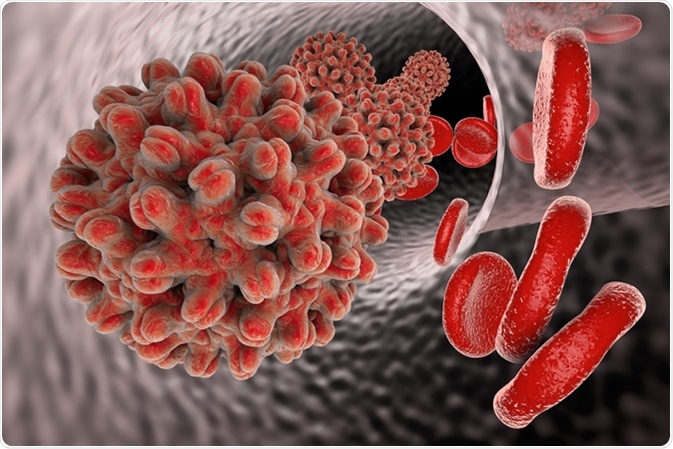Hepatitis B virus (HBV) is a common cause of liver disease and accounts for approximately one million deaths worldwide every year. This virus is of the Hepadnaviridae family and its genome comprises a partially double-stranded relaxed circular DNA (rcDNA).
The genome of HBV exists in two forms including the circular covalently closed DNA (cccDNA) and rcDNA. In early HBV infection, the genomic rcDNA is converted to cccDNA in the newly infected cell.

Image Credit: Kateryna Kon / Shutterstock
Relation between HBV Infection and cccDNA
The molecular mechanism of HBV infection and its persistence has not yet been understood fully. This mechanism appears to be multifactorial involving many co-activators, co-repressors, transcription factors, and chromatin-modifying enzymes.
In HBV infection, the cccDNA interacts with histones and non-histones, with the transcription of cccDNA being regulated by histone acetylation. This post-translational histone modification manifests as low viremia in patients infected by HBV.
Diagnostic methods
With research proving that HBV is characterized by the presence of the viral genome, cccDNA, in infected hepatocytes, any breakthrough in achieving a complete cure of HBV will require a thorough understanding of the biogenesis, regulation, and stability of cccDNA.
Diagnostic methods such as the Southern blot and reverse transcription-polymerase (RT-PCR) reaction are time-consuming and labor-intensive techniques that are not highly precise. To overcome these limitations, a number of genome editing tools have been developed that are capable of cleaving specific sequences of DNA.
Many studies have used these tools to excise the viral cccDNA. Examples of such tools include the clustered regularly interspaced short palindromic repeats/Cas9 system (CRISPR/Cas9), zinc finger nucleases (ZFNs), and transcription activator-like effector nucleases (TALENs).
ZFNs and TALENs
Both ZFNs and TALENs are chimeric nucleases that have been engineered to facilitate targeted genome editing. These chimeric nucleases work by creating double-stranded breaks (DSBs) in the DNA at the specified location, which then stimulate the cell's natural DNA-repair processes.
By generating targeted genomic edits, parental cell lines with targeted gene deletion, modifications, or integration can be produced.
CRISPR/Cas9
Out of the three types of CRISPR mechanisms that have been identified, type II has been used extensively for research purposes. The type II CRISPR mechanism consists of only one Cas protein, which is the Cas9 protein.
The Cas9 protein forms a complex with the single guide RNA and causes site-specific DSBs via the RNA-DNA complementary base pairing.
Therapies for HBV
The available antiviral therapies, such as nucleoside analogs, do not cure HBV infection and require lifelong administration to contain the infection. Sometimes, HBV develops resistance to these drugs upon long-term administration.
The presence of this recalcitrant cccDNA leads to a relapse of viremia, even after therapy. In addition, the level of the HBV cccDNA in human liver cells is extremely low, thereby requiring highly sensitive methods of measurement.
The use of gene therapy to stop the replication of HBV has been gaining considerable momentum. With different genome editing tools, the cccDNA can be disabled by targeted mutagenesis. For example, RNA-guided nucleases (RGNs) comprised of CRISPR RNA (crRNA) and trans-activating crRNA (tracrRNA). The crRNA has a sequence that is complementary to a pre-defined DNA target sequence, thereby leading to cleavage of the target DNA.
Hepatitis B: Treatment and care for a chronic condition | Ohio State Medical Center
Epigenetic gene splicing is another method that is used to treat HBV infection. This method involves the chemical alteration of DNA without any change to the genetic code. Examples of epigenetic modifications are cccDNA methylation and cccDNA minichromosome acetylation.
The major epigenetic modifiers of HBV DNA are histone acetyltransferases and lysine/DNA/arginine methyltransferases. Studies have demonstrated that histone deacetylases inhibitors suppress cccDNA in duck HBV.
Immunomodulators such as interferon-alpha (IFN-α) are used for the functional cure of HBV infection. However, this therapy has a very low efficacy rate and considerable side effects. One study has demonstrated that modified IFN-α improves their safety profile and helps in maintaining antiviral efficacy in HBV transgenic mice.
Conclusion
A complete cure for chronic HBV infections will require extensive research to develop innovative therapeutic approaches that can act effectively inhibit the persistent episomal cccDNA. Irrespective of the challenges of gene-based therapy for HBV infection, this field is rapidly gaining momentum and making good strides to provide therapeutic solutions that are highly effective with reduced toxicity profiles.
References
Further Reading
Last Updated: May 24, 2021